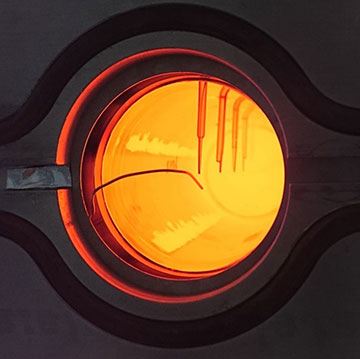
Researchers at ETH Zurich have made a thermal trapping device for converting concentrated sunlight into heat that can reach a temperature of 1050°C. [Image: Device / Casati et al.]
Industrial processes requiring high temperatures might in the future be powered by concentrated solar energy rather than fossil fuels, so say researchers in Switzerland (Device, doi: 10.1016/j.device.2024.100399). The team led by Emiliano Casati, ETH Zurich, has shown that adding a length of semi-transparent material such as quartz to an opaque radiation absorber can boost the latter's operating efficiency significantly―even at temperatures as high as 1000°C.
Boosting efficiency
High temperatures are needed in everything from cement manufacturing to steelmaking. It is possible to concentrate the sun's rays to yield heat with temperatures as high as 3000°C, but above about 1000°C this form of energy generation usually becomes inefficient due to losses incurred via re-radiation. As such, most high-temperature manufacturing relies on energy from fossil fuels―which emit copious amounts of greenhouse gases.
In principle, efficiencies can be raised considerably by attaching a piece of semi-transparent material to the front of an opaque absorber. Opaque materials absorb solar radiation and transfer the energy by conducting it through their bulk, but once the absorber reaches high temperatures, it re-radiates much of the energy away at infrared wavelengths. In contrast, the semi-transparent part allows most of the incoming visible radiation to pass through its volume and reach the absorber but then absorbs much of the infrared radiation that the latter gives off.
This allows the composite device to retain more of the incoming energy than would otherwise be the case. The result is a higher temperature at the absorber than on the sun-facing surface of the transparent material, showing that less concentrated sunlight can be used to yield a given output temperature (the absorber alone instead sees the highest temperature on its front surface). This implies a higher conversion efficiency, which entails fewer solar collectors for a given system output―meaning less is spent on expensive optics, resulting in a potentially more cost-effective option for manufacturers.
Quartz thermal traps
This concept of "thermal trapping" was first demonstrated experimentally by Milan Cobble and colleagues at New Mexico State University, USA, as far back as 1966. That research involved quite low temperatures―it featured an insulated plastic box that reached 170°C on its blackened bottom face while experiencing less than 60°C on its outer surface. However, significantly raising the absorber temperature has proved an uphill struggle.
Casati and colleagues at ETH Zurich have now demonstrated how much higher temperatures could be achieved. They held one end of a 30 cm–long quartz rod in contact with an opaque silicon carbide disk and exposed the other end to concentrated solar-like radiation from ETH’s high-flux solar simulator. The team then measured the temperature profile of the setup, having inserted a number of thermocouples at different points along the rod's axis and another one in the absorber disk.
The final temperature of the absorber reached about 1050°C while the exposed surface of the quartz rod got up to just 450°C.
The researchers ran the experiment a number of times, halting each one when they obtained steady-state temperatures along the rod—which typically happened after about eight hours—without attempting to remove the heat using a heat transfer fluid. The final temperature of the absorber reached about 1050°C while the exposed surface of the quartz rod got up to just 450°C. With the temperature of the absorber corresponding to an emission peak at about 1.5 µm, they calculated that more than half of the energy that would normally be radiated away from the absorber would instead be trapped inside the quartz.
Modeling heat transfer
To extrapolate their experimental results to a wide range of operating conditions, they developed a heat transfer model and validated it by finding a good agreement between the predicted and measured temperatures. They found that shielding an absorber with 10 cm of quartz yields higher maximum temperatures across a wide range of solar concentrations compared with an unshielded receiver.
By adding a simulated heat sink, they then worked out that including a shield of 30 cm should boost the efficiency of an absorber reaching 1200°C under 500 suns from about 40% to nearer 70%. Conversely, they found that the unshielded absorber would need to be exposed to twice that solar concentration to match the 70% efficiency level.
“Thermal trapping has the potential to drastically improve the efficiency of concentrating solar receivers,” they conclude, “particularly under conditions where increasing concentration is not feasible.”
First, however, the researchers are working to contain the cost of their scheme. Although Casati reckons that the semi-transparent material itself will not be expensive, he cautions that ensuring it functions properly could be a challenge. He explains that a solid material such as quartz would need to be durable under high-flux solar radiation, whereas a liquid like water or a gas like carbon dioxide would require the receiver to be redesigned.
The researchers are also looking at ways to reduce reflection from the semi-transparent material, which imposes a cap on the maximum efficiency that a shielded device can achieve. Options for reducing this reflection, they say, include using surface treatments such as coatings or geometrical patterning.

